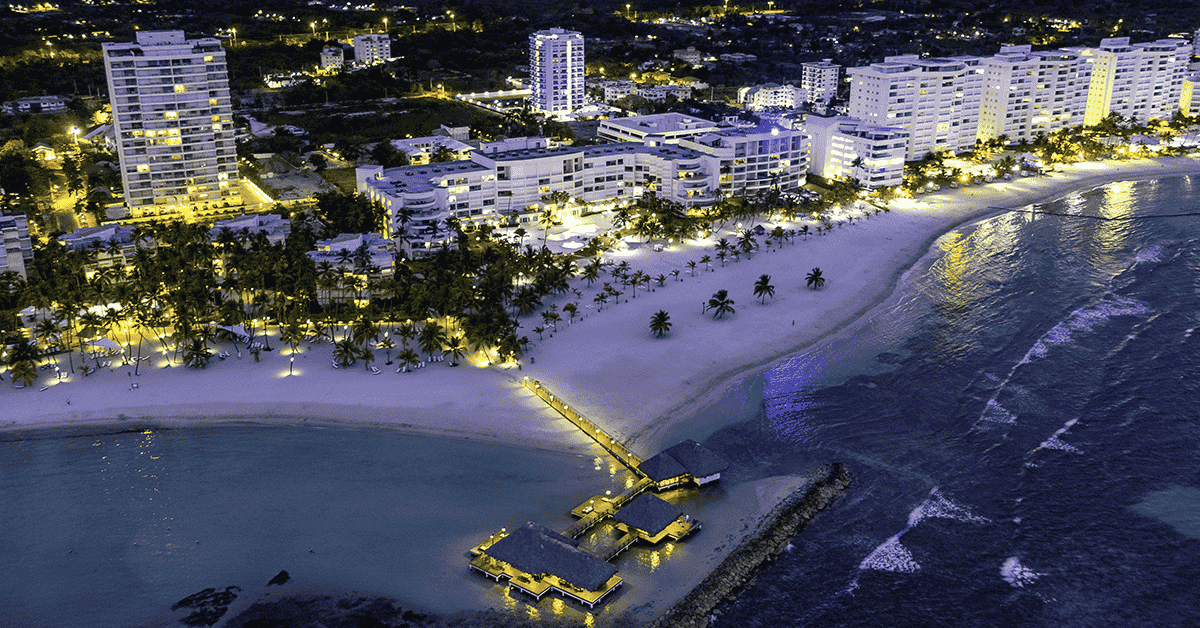
Dominican Republic
Explore Dominican Republic
Dominican Republic
Dominican Republic: The Heart of the Caribbean
The Dominican Republic is a breathtaking Caribbean destination known for its stunning beaches, lush mountains, and vibrant culture. Home to world-class resorts, rich colonial history, and thrilling adventure activities, this island offers a perfect mix of relaxation, exploration, and nightlife. Whether you're lounging on Punta Cana’s white sands, hiking to waterfalls, or dancing to merengue in Santo Domingo, the Dominican Republic is a must-visit destination for beach lovers, adventure seekers, and cultural explorers alike.
Learn More
Frequently Asked Questions: Dominican Republic
The Dominican Republic enjoys warm tropical weather year-round, but some seasons are better than others:
- December–April (Peak Season): Best for sunny weather, beach activities, and festivals.
- May–August (Shoulder Season): Ideal for fewer crowds and great hotel deals.
- September–November (Hurricane Season): Great for budget travelers, but keep an eye on weather forecasts.
- Punta Cana & Bávaro Beach – The most famous beach destination, lined with luxury resorts and crystal-clear waters.
- Santo Domingo’s Zona Colonial – A UNESCO World Heritage Site featuring historic Spanish architecture.
- Saona Island – A tropical paradise with pristine beaches and turquoise waters.
- Los Haitises National Park – A lush natural reserve with mangroves, caves, and unique rock formations.
- Damajagua Waterfalls – A series of 27 cascading waterfalls perfect for canyoning and swimming.
- Samaná Peninsula – Known for whale watching, hidden beaches, and stunning landscapes.
- Jarabacoa – The eco-adventure capital, ideal for hiking, whitewater rafting, and waterfalls.
- Altos de Chavón – A picturesque Mediterranean-style village with shops, art galleries, and an amphitheater.
- Playa Rincón – One of the most beautiful and unspoiled beaches in the Caribbean.
- Cayo Levantado (Bacardi Island) – A tiny island famous for its palm-fringed beaches and rum cocktails.
- Mangu – A traditional breakfast dish made of mashed plantains, topped with onions.
- La Bandera Dominicana – The national dish consisting of rice, beans, and stewed meat.
- Sancocho – A hearty Dominican stew made with meats, root vegetables, and spices.
- Mofongo – A mashed plantain dish mixed with garlic, pork cracklings, or seafood.
- Chimichurri (Chimi Burger) – A popular street food burger topped with cabbage and pink sauce.
- Tostones – Twice-fried green plantains served with dipping sauces.
- Pica Pollo – Dominican-style crispy fried chicken, seasoned to perfection.
- Dulce de Coco – A sweet coconut dessert made with condensed milk and cinnamon.
- Presidente Beer – The most popular local beer, perfect for cooling off on the beach.
- Mamajuana – A traditional Dominican drink made with rum, honey, red wine, and herbs.
- Flights: Arrive at Punta Cana International Airport (PUJ), Las Américas International Airport (SDQ), or Cibao International Airport (STI).
- Car Rentals: Recommended for exploring beyond the resorts, but be cautious with local driving styles.
- Taxis: Available, but agree on a price before riding since most don’t use meters.
- Public Buses (Guaguas): Budget-friendly but can be crowded and unpredictable.
- Metro Santo Domingo: The only subway system in the Caribbean, ideal for getting around the capital.
- Motoconchos (Motorcycle Taxis): Fast and cheap, but best for short distances.
- Ferries & Boats: Available for trips to Saona Island, Samaná, and other coastal destinations.
- For U.S. travelers: No visa required for stays up to 30 days, but a valid passport is necessary.
- For international travelers: Check the Dominican Republic’s visa requirements based on your nationality.
- Tourist Card Fee: Included in airline tickets—no need to purchase separately.
- Currency: Dominican Peso (DOP).
- S. dollars are accepted in many tourist areas, but pesos offer better exchange rates.
- Credit cards are widely accepted, but some local markets and taxis prefer cash.
- ATMs are available in major cities and resort areas.
- Currency exchange is available at banks, hotels, and exchange bureaus.
- Spanish is the official language.
- English is widely spoken in resorts, hotels, and tourist areas.
- Learning basic Spanish phrases can be helpful when visiting local markets or rural areas.
- Dominicans are warm and hospitable—greet people with a handshake or a kiss on the cheek.
- Tipping is customary (10-15% at restaurants, and for taxi drivers and tour guides).
- Beachwear is fine at resorts, but dress modestly when visiting towns or churches.
- Dancing is a big part of the culture—merengue and bachata are the national rhythms!
- Respect local customs and don’t take photos of people without permission.
- Restaurants: 10–15% tip is standard, but some places include a service charge.
- Bars: $1–2 per drink or 10–15% of the total bill.
- Hotels: $2–5 per bag for bellhops, $2–5 per night for housekeeping.
- Taxis: Tipping is expected, usually around 10% of the fare.
- Tour Guides & Excursions: $10–20 per person for excellent service.
- For peak travel season (December–April): Book 6–12 months in advance for resorts and flights.
- For off-season travel (May–November): Booking a few weeks ahead is usually fine.
- For popular excursions like Saona Island: Book at least a few weeks in advance.
- No COVID-19 test is required for entry, but check for updates before traveling.
- Some national parks and private beaches require entrance fees—bring small cash for access.
- Mosquito repellent is recommended—especially in jungle areas and near waterfalls.
Contact us at281-229-0862 or admin@pointmetoparadise.com
